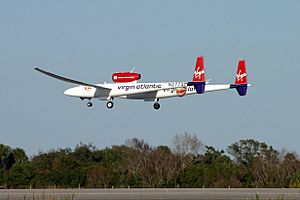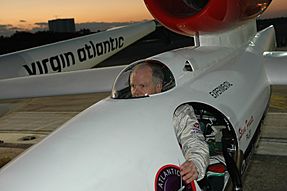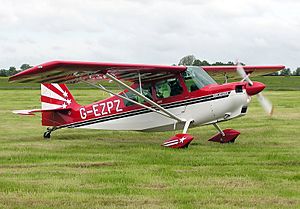Steve Fossett facts for kids
Quick facts for kids
Steve Fossett
|
|
|---|---|
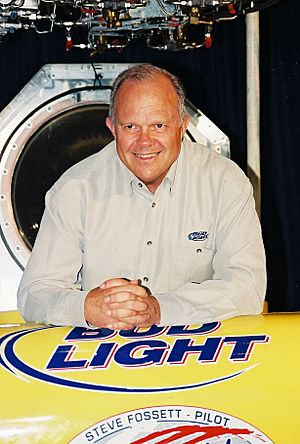
Fossett in September 2002
|
|
| Born |
James Stephen Fossett
April 22, 1944 Jackson, Tennessee, U.S.
|
| Died | September 3, 2007 (aged 63) |
| Cause of death | Plane crash |
| Alma mater | Garden Grove High School Washington University in St. Louis Stanford University |
| Known for | setting a large number of world records as an adventurer, sailor and aviator |
| Spouse(s) | Peggy Viehland |
James Stephen Fossett (born April 22, 1944 – died September 3, 2007) was an American businessman and an amazing adventurer. He set many world records as a pilot, sailor, and explorer. Steve Fossett was the first person to fly alone around the world without stopping in both a hot air balloon and a special airplane.
He earned his money in the financial world. He held five world records for traveling around the Earth without stopping. These included journeys by hot air balloon, sailboat, and airplane.
Steve Fossett was a member of important groups like the Royal Geographical Society. He set over 100 records in five different sports. Sixty of these records were still unbroken when he died. He broke three of the seven biggest world records for airplanes in his Virgin Atlantic GlobalFlyer. In 2002, he won the Gold Medal from the Royal Aero Club in the UK. In 2007, he was added to the National Aviation Hall of Fame.
Fossett disappeared on September 3, 2007. He was flying a small plane over the Great Basin Desert between Nevada and California. His plane was found crashed in 2008.
Early Life and Adventures
Steve Fossett was born in Jackson, Tennessee. He grew up in Garden Grove, California. He finished high school there.
His love for adventure started when he was young. As a Boy Scout, he climbed mountains in California. He began with the San Jacinto Mountains. Fossett once said, "When I was 12 years old I climbed my first mountain, and I just kept going." He found that he was good at activities that needed a lot of effort and staying power. His father, an Eagle Scout, encouraged him to explore. Steve became an Eagle Scout at age 13. He was also a leader in the Boy Scouts' honor society. He worked as a Ranger at Philmont Scout Ranch in New Mexico in 1961. Fossett said that Scouting was the most important thing he did when he was young.
At Stanford University, Fossett was already known for his adventures. His friends dared him to swim to Alcatraz. He swam there to put up a banner. A security guard stopped him when he arrived. Fossett graduated from Stanford in 1966 with a degree in economics. After college, he spent a summer in Europe. He climbed mountains and swam the Dardanelles.
How Steve Fossett Earned His Money
In 1968, Fossett earned a business degree from Washington University in St. Louis. He later became a successful commodities salesman in Chicago. He worked for big companies like Merrill Lynch.
In 1980, Fossett started his own companies, Marathon Securities and Lakota Trading. He made a lot of money by renting out trading permits to other traders. These traders also paid fees to his companies. By 1997, his companies were very successful. Fossett used the money he earned to pay for his amazing adventures. He said, "As a floor trader, I was very aggressive and worked hard. Those same traits help me in adventure sports."
Fossett later sold most of his business interests. He kept an office in Chicago until 2006.
Personal Connections
In 1968, Steve Fossett married Peggy Viehland. They did not have any children. The Fossetts had homes in Colorado and Chicago. They also had a vacation home in Carmel, California.
Steve Fossett became well known in the United Kingdom. This was because of his friendship with billionaire Richard Branson. Branson's company, Virgin Group, helped pay for some of Fossett's adventures.
Steve Fossett's Amazing Records
Overview of Records
Steve Fossett was famous for his many world records. He achieved these in balloons, sailboats, gliders, and powered airplanes. He was a pilot with a huge range of experience. He wanted to be the first person to fly a balloon around the world alone. He finally did it on his sixth try in 2002. This made him the first person to fly around the world alone without stopping or refueling in any type of aircraft.
With his co-pilot Terry Delore, he set 10 glider records. These included the first 2,000 km (1,243 miles) Out-and-Return flight. Before Fossett, no pilot had held world records in more than one type of aircraft. Fossett held records in four different types!
In 2005, Fossett made the first solo, nonstop flight around the world in an airplane. He did this in 67 hours in the Virgin Atlantic GlobalFlyer. This was a single-engine jet.
In 2006, he flew around the world again without stopping or refueling. This flight took 76 hours and 45 minutes in the GlobalFlyer. He set the record for the longest flight by any aircraft in history. The distance was 25,766 miles (41,467 km).
He set 91 aviation world records. The Fédération Aéronautique Internationale confirmed these records. Thirty-six of them are still unbroken. He also set 23 sailing world records.
On August 29, 2006, he set the world altitude record for gliders. He flew over El Calafate, Argentina, reaching 15,460 meters (50,722 feet).
Balloon Pilot Records

On February 21, 1995, Fossett landed in Leader, Saskatchewan, Canada. He had taken off from South Korea. This made him the first person to fly alone across the Pacific Ocean in a balloon.
In 2002, he became the first person to fly around the world alone without stopping in any type of aircraft. He launched his huge balloon, called Spirit of Freedom, from Northam, Western Australia. This was on June 19, 2002. He returned to Australia on July 3, 2002, landing in Queensland. This solo balloon flight lasted 13 days, 8 hours, and 33 minutes. He traveled 20,626 miles (33,195 km). At the end, the balloon dragged him along the ground for 20 minutes. Only the capsule survived the landing. It is now on display at the Smithsonian Institution in Washington, D.C.
This trip set several ballooning records:
- Fastest Around the World (13.5 days)
- Longest Distance Flown Solo in a Balloon (20,482 miles or 32,963 km)
- Longest 24-Hour Balloon Distance (3,186 miles or 5,129 km on July 1)
Steve Fossett paid for five of his previous balloon attempts himself. His successful record-setting flight was sponsored by Bud Light. He even made money from his balloon flights. He bought an insurance policy for $500,000 that would pay him $3 million if he succeeded. This, along with sponsorships, meant he didn't have to spend his own money on the main costs.
Sailor Records
Fossett was one of sailing's most successful record holders for long distances. Speed sailing was his special skill. From 1993 to 2004, he set 23 official world records and nine distance race records. The World Sailing Speed Record Council called him "the world's most accomplished speed sailor."
On his large catamaran, Cheyenne, Fossett twice set the famous 24 Hour Record of Sailing. In October 2001, Fossett and his crew set a transatlantic record. They crossed the Atlantic in 4 days and 17 hours. This broke the old record by more than 43 hours.
In early 2004, Fossett, as the captain, set the Around the world sailing record. He sailed around the world in 58 days and 9 hours on Cheyenne with a crew of 13. In 2007, Fossett held the world record for crossing the Pacific Ocean. He did this in his 125-foot (38-meter) sailboat, the PlayStation. This was on his fourth try.
Airship Pilot Records
Fossett set the world speed record for airships on October 27, 2004. He achieved this with a Zeppelin NT. The airship flew at an average speed of 62.2 knots (115 km/h or 71 mph). The old record was 50.1 knots (92.8 km/h or 57.6 mph). In 2006, Fossett was one of only 17 pilots in the world allowed to fly the Zeppelin.
Fixed-Wing Aircraft Pilot Records
GlobalFlyer Flights
Fossett made the first solo nonstop flight around the world in an airplane. This happened between February 28 and March 3, 2005. He took off from Salina, Kansas. He flew east with the wind. He returned to Salina after 67 hours, 1 minute, and 10 seconds. He did this without refueling or landing. His average speed of 342.2 mph (550.7 km/h) was also a world record. His plane, the Virgin Atlantic GlobalFlyer, was made of a special carbon fiber material. It had one engine. Burt Rutan and his company, Scaled Composites, designed and built it.
On February 11, 2006, Fossett set the world record for "distance without landing." He flew from the Kennedy Space Center, Florida, around the world. Then he continued across the Atlantic Ocean a second time. He landed in Bournemouth, England. The official distance was 25,766 miles (41,467 km). The flight lasted 76 hours and 45 minutes.
The next month, Fossett made a third flight around the world. He wanted to break the record for "Distance over a closed circuit without landing." This means taking off and landing at the same airport. He took off from Salina, Kansas, on March 14, 2006. He returned on March 17, 2006. He flew 25,262 miles (40,655 km).
There are only seven absolute world records for airplanes. Fossett broke three of them in the Virgin Atlantic GlobalFlyer. These records were previously held by Dick Rutan and Jeana Yeager in their plane, the Rutan Voyager, in 1986. Fossett gave the GlobalFlyer to the Smithsonian Institution. It is now on display at the Steven F. Udvar-Hazy Center. Fossett even flew the plane to the center himself.
Transcontinental Aircraft Records
Fossett set two U.S. transcontinental airplane records on the same day. On February 5, 2003, Fossett and co-pilot Doug Travis flew his Cessna Citation X jet. They went from San Diego, California, to Charleston, South Carolina. The flight took 2 hours, 56 minutes, and 20 seconds. Their average speed was 726.83 mph (1,169.7 km/h). This broke the record for non-supersonic jets.
He then flew back to San Diego. After that, he flew the same route as co-pilot for Joe Ritchie. They used Ritchie's turboprop Piaggio P.180 Avanti. Their time was 3 hours, 51 minutes, and 52 seconds. Their average speed was 546.44 mph (879.4 km/h). This broke the old turboprop record.
Fossett also set the east-to-west transcontinental record. This was for non-supersonic airplanes. He flew from Jacksonville, Florida, to San Diego, California. The flight took 3 hours and 29 minutes. His average speed was 591.96 mph (952.6 km/h).
First Trans-Atlantic Flight Re-enactment
On July 2, 2005, Fossett and co-pilot Mark Rebholz repeated the first nonstop flight across the Atlantic. This first flight was made by John Alcock and Arthur Whitten Brown in June 1919. They used a Vickers Vimy biplane. Fossett and Rebholz flew their replica Vickers Vimy from St. John's, Newfoundland, Canada, to Clifden, Ireland. The flight took 18 hours and 25 minutes. They landed on a golf course because there was no airport in Clifden.
Glider Records
Steve Fossett and Terry Delore (from New Zealand) set ten official world records in gliders. They flew in New Zealand, Argentina, and Nevada, United States.
- 1,000 km (621 miles) Out-and-Return World Record (166.46 km/h or 103.43 mph), December 12, 2002.
- 750 Kilometer (466 miles) Triangle World Record (171.29 km/h or 106.43 mph), July 29, 2003.
- 1,500 km (932 miles) Out-and-Return World Record (156.61 km/h or 97.31 mph), November 14, 2003.
- Out-and-Return Distance (Declared) World Record 1,804.7 km (1,121.4 miles), November 14, 2003.
- Out and Return Distance (Free) World Record 2,002.44 km (1,244.26 miles), November 14, 2003.
- 500 Kilometer (311 miles) Triangle World Record (187.12 km/h or 116.27 mph), November 15, 2003.
- 1,500 Kilometer (932 miles) Triangle World Record (119.11 km/h or 74.01 mph), December 13, 2003.
- Triangle Distance (Declared) World Record 1,502.6 km (933.7 miles), December 13, 2003.
- Triangle Distance (Free) World Record 1,509.7 km (938.1 miles), December 13, 2003.
- Distance (Free) World Record 2,192.9 km (1,362.6 miles), December 4, 2004.
Fossett and co-pilot Einar Enevoldson flew a glider into the stratosphere on August 29, 2006. This flight set the Absolute Altitude Record for gliders. They reached 15,460 meters (50,722 feet). The glider's cockpit was not pressurized. So, the pilots wore special pressure suits, like space suits. This allowed them to fly to such high altitudes. This project is known as the Perlan Project.
Cross-Country Skiing
When he was younger, Fossett was one of the first people to take part in the Worldloppet. This is a series of cross-country ski marathons around the world. He didn't have much skiing experience. But he was in the first group of "citizen athletes" to join in 1979. In 1980, he became the eighth skier to finish all 10 long-distance races. He earned a Worldloppet medallion for this.
Mountain Climbing
Fossett loved mountain climbing his whole life. He had climbed the highest peaks on six of the seven continents. In the 1980s, he became friends with Patrick Morrow. Morrow was trying to climb the highest peaks on all seven continents. Fossett joined Morrow for his last three peaks. These included Vinson Massif in Antarctica and Carstensz Pyramid in Oceania. Fossett climbed almost all of the Seven Summits himself. However, he did not climb Mount Everest in 1992 because of asthma.
Other Accomplishments
Fossett competed in and finished many tough endurance sports events. He completed the 1,165-mile (1,875 km) Iditarod Trail Sled Dog Race. He finished 47th on his second try in 1992. He trained for five years for this race. He became the 270th person to swim across the English Channel. He did this on his fourth try in September 1985. It took him 22 hours and 15 minutes. Fossett said he wasn't a great swimmer. But he found he could swim for very long times.
Fossett also competed in the Ironman Triathlon in Hawaii. He finished in 1996. He ran the Boston Marathon. He also ran the Leadville Trail 100. This is a 100-mile (160 km) Colorado ultramarathon. It involves running up mountains over 12,600 feet (3,840 meters) high.
Fossett raced cars in the mid-1970s. He returned to the sport in the 1990s. He competed in the 24 Hours of Le Mans road race in 1993 and 1996. He also took part in the Dakar Rally.
Previous Attempts at Records
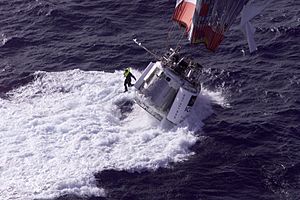
Fossett tried six times over seven years to be the first to fly a balloon around the world alone. His fifth try cost him $1.25 million of his own money. His sixth and successful attempt had commercial sponsors. Two of his attempts started from Busch Memorial Stadium in St. Louis, Missouri. Washington University in St. Louis was the control center for four of his six flights. This included the record-breaking one.
In 1998, one of his unsuccessful balloon attempts ended badly. He fell five miles (8 km) into the Coral Sea off Australia. He almost died. He waited 72 hours to be rescued. This rescue cost $500,000. His first attempt started in South Dakota. It ended 1,800 miles (2,900 km) later in New Brunswick, Canada. The second attempt cost $300,000. It lasted 9,600 miles (15,450 km) before landing in a tree in India. This trip set records for flight duration and distance at the time. Fossett slept only about two hours a night during the six-day journey.
Scouting and Its Impact
Fossett grew up in Garden Grove, California. He earned the Eagle Scout award in 1957. He said his experiences in Scouting helped him succeed later in life. "As a Scout, I learned how to set goals and achieve them," he once said. "Being a Scout also taught me leadership at a young age." He added that Scouting values stayed with him in his business career and adventures. Later in his life, other Scouts called him a "legend."
As a volunteer for the Boy Scouts of America (BSA), he held several important roles. He was Chairman of the Northern Tier High Adventure Committee. He was also Chairman of the Venturing Committee. He served on the Philmont Ranch Committee and the National Advisory Council. He became a member of the BSA National Executive Board. In 2007, Fossett became president of the National Eagle Scout Association. He had also served on the World Scout Committee.
Fossett received the Distinguished Eagle Scout Award in 1992. In 1999, he got the Silver Buffalo Award. This is the BSA's highest award for service to young people.
Awards and Honors
In 2002, Fossett received aviation's highest award. This was the Gold Medal of the Fédération Aéronautique Internationale (FAI). In July 2007, he was added to the National Aviation Hall of Fame. Dick Rutan presented him at the ceremony.
In 1997, Fossett was added to the Balloon and Airship Hall of Fame. In February 2002, he was named America's Rolex Yachtsman of the Year. This was by the American Sailing Association. He was the oldest person to receive this award. He was also the only one to fly himself to the ceremony in his own plane.
He received the Explorers Medal from the Explorers Club. This was after his solo balloon flight around the world. He also received the Diplôme de Montgolfier in 1996. He won the Harmon Trophy in 1998 and 2002. This award is given to the world's best aviator. He received the Grande Médaille of the Aéro-Club de France. He also got the British Royal Aero Club's Gold Medal in 2002. In 2003, he received the Order of Magellan and France's Médaille de l'Aéronautique.
The White Knight Two VMS Spirit of Steve Fossett was named after him. His friend Richard Branson did this in late 2007. After he disappeared, Peggy Fossett and Dick Rutan accepted the Spread Wings Award for him. This was at the 2007 Spreading Wings Gala in Denver, Colorado.
In 2010, Fossett was added to the International Air & Space Hall of Fame. This is at the San Diego Air & Space Museum.
Disappearance and Discovery
The Search for Steve Fossett
On the morning of Monday, September 3, 2007, Steve Fossett took off. He was flying a single-engine Champion 8KCAB Super Decathlon plane. He left from the Flying-M Ranch private airstrip in Nevada. When he did not return, searches began about six hours later. The plane's emergency beacon did not send a signal. This type of beacon was known for not working after a crash.
Fossett had enough fuel for four to five hours of flight. He did not file a flight plan, which was not required for his flight.
The Civil Air Patrol (CAP) started a large search. It grew to cover almost 20,000 square miles (52,000 km²) of very rough land. By September 10, search crews had found eight old crash sites. These were not Fossett's plane. About two dozen aircraft were involved in the search.
Google Inc. helped the search. They used satellite images for their Google Earth software. Richard Branson worked with Google to look for Fossett's plane in high-resolution images. People could also help by looking at images online. By September 11, about 50,000 people had joined. They looked at over 300,000 small squares of images. However, this online effort did not find the plane.
On September 17, the Civil Air Patrol stopped its search flights. Other private and ground searches continued. The National Transportation Safety Board (NTSB) started looking into the likely crash.
On October 2, 2007, the Civil Air Patrol announced it had stopped its search. This search was the largest peacetime search for one person in U.S. history.
Finding the Wreckage and Remains
On September 29, 2008, a hiker found three ID cards. They were in the eastern Sierra Nevada mountains in California. This was about 65 miles (105 km) south of where Fossett took off. The cards were confirmed to belong to Fossett. They included his pilot's license and $1,005 in cash.
On October 1, air search teams saw wreckage on the ground. It was at an elevation of 10,100 feet (3,078 meters). This was about 750 yards (686 meters) from where the ID cards were found. Later, they confirmed it was Fossett's plane.
The crash site is on the western side of a ridge called Volcanic Ridge. It is about 300 feet (91 meters) below the top of the ridge. The area is steep and has some pine trees and rocks.
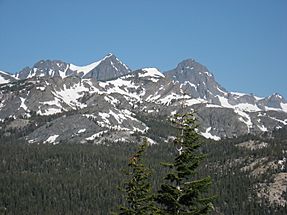
The crash site is inside the Ansel Adams Wilderness in California. Nearby places include Minaret Lake and the town of Mammoth Lakes. The site is 10 miles (16 km) east of Yosemite National Park.
Over the next two days, ground searchers found small bone fragments. On October 29, search teams found two larger human bones. These were about 0.5 miles (0.8 km) east of the crash site. Tennis shoes with animal bite marks were also found.
On November 3, police confirmed the bones matched Fossett's DNA. Officials said Fossett would have died instantly in such a crash. It was not unusual for animals to move remains.
NTSB Report on the Crash
On March 5, 2009, the NTSB released its report. The report said the plane crashed at about 10,000 feet (3,048 meters). The peaks in the area are over 13,000 feet (3,962 meters). The air was thin at the time, making it harder for the plane to climb.
The plane was almost 30 years old. Fossett had flown this type of plane for about 40 hours. The plane's manual said it could climb 300 feet (91 meters) per minute at 13,000 feet (3,962 meters).
The NTSB report said that weather models showed strong downdrafts (air moving downwards) of about 300 feet (91 meters) per minute in the crash area. There was no sign that the plane had any equipment problems.
The report stated that Fossett died from many injuries from the crash. The emergency beacon was destroyed.
On July 9, 2009, the NTSB said the crash was likely caused by "the pilot's accidental encounter with downdrafts that were stronger than the airplane's ability to climb." The downdrafts, thin air, and mountains all played a part in the accident.
Images for kids
See also
 In Spanish: Steve Fossett para niños
In Spanish: Steve Fossett para niños


